
Snowshoes are specialized outdoor gear for walking over snow. Their large footprint spreads the user's weight out and allows them to travel largely on top of rather than through snow. Adjustable bindings attach them to appropriate winter footwear.
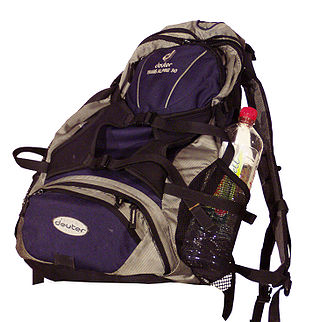
A backpack—also called knapsack, rucksack, pack, booksack, bookbag, haversack or backsack—is, in its simplest frameless form, a fabric sack carried on one's back and secured with two straps that go over the shoulders; but it can have an external or internal frame, and there are bodypacks.

Modular Lightweight Load-carrying Equipment, or MOLLE, is the current generation of load-bearing equipment and backpacks used by a number of NATO armed forces, especially the British Army and the United States Army.

Backpacking is the outdoor recreation of carrying gear on one's back while hiking for more than a day. It is often an extended journey and may involve camping outdoors. In North America, tenting is common, where simple shelters and mountain huts, widely found in Europe, are rare. In New Zealand, hiking is called tramping, and tents are used alongside a nationwide network of huts. Hill walking is equivalent in Britain, though backpackers make use of a variety of accommodation, in addition to camping. Backpackers use simple huts in South Africa. Trekking and bushwalking are other words used to describe such multi-day trips.

Backpacking is a form of low-cost, independent travel, which often includes staying in inexpensive lodgings and carrying all necessary possessions in a backpack. Once seen as a marginal form of travel undertaken only through necessity, it has become a mainstream form of tourism.

A baby sling or baby carrier is generally made of soft fabrics that wrap around the chest. They provide comfort and support for the baby and allow the parent or carer to keep their hands free as they go about their everyday tasks.

A handbag, commonly known as a purse in North American English, is a handled medium-to-large bag used to carry personal items. It has also been called a pocketbook in parts of the U.S.
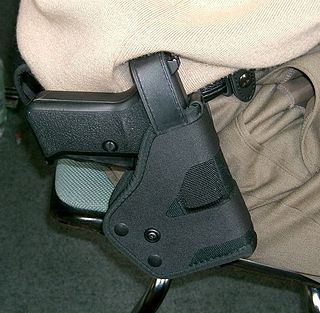
A handgun holster is a device used to hold or restrict the undesired movement of a handgun, most commonly in a location where it can be easily withdrawn for immediate use. Holsters are often attached to a belt or waistband, but they may be attached to other locations of the body. Holsters vary in the degree to which they secure or protect the firearm. Some holsters for law enforcement officers have a strap over the top of the holster to make the handgun less likely to fall out of the holster or harder for another person to grab the gun. Some holsters have a flap over the top to protect the gun from the elements.
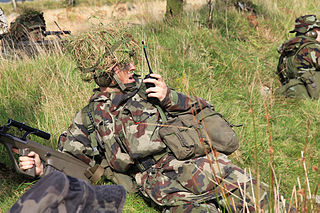
Personal Load Carrying Equipment (PLCE) is one of several tactical webbing systems of the British Armed Forces. Dependent upon the year of design, and the decade of introduction, the webbing system was named and is commonly referred to as the 85 Pattern, the 90 Pattern or the 95 Pattern webbing.
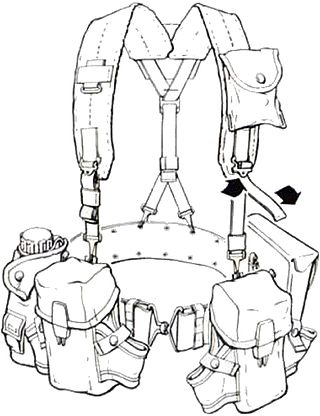
The All-Purpose Lightweight Individual Carrying Equipment (ALICE) is a set of load-carrying equipment adopted as United States Army Standard A on 17 January 1973 to replace the M-1956 Individual Load-Carrying Equipment (ILCE) and M-1967 Modernized Load-Carrying Equipment (MLCE). Although since superseded by MOLLE, ALICE gear is still in some limited use with the U.S. Army National Guard, State Guard, also some ground units of the Navy and Air Force.

Sidemount is a scuba diving equipment configuration which has scuba sets mounted alongside the diver, below the shoulders and along the hips, instead of on the back of the diver. It originated as a configuration for advanced cave diving, as it facilitates penetration of tight sections of cave, allows easy access to cylinder valves, provides easy and reliable gas redundancy, and tanks can be easily removed when necessary. These benefits for operating in confined spaces were also recognized by divers who conducted technical wreck diving penetrations.
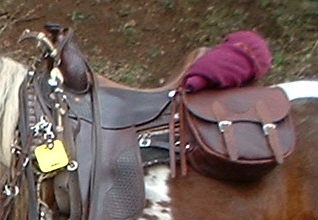
Saddlebags are bags that are attached to saddles.

A Duluth pack, is a traditional portage pack used in canoe travel, particularly in the Boundary Waters region of northern Minnesota and the Quetico Provincial Park of Ontario. It is a specialized type of backpack that is designed to fit in the bottom of canoes. Originally known as the "Poirier pack" or "Poirier pack-sack", the pack style later became known as the "Duluth pack", as its original, eponymous manufacturing company is located in Duluth, Minnesota.
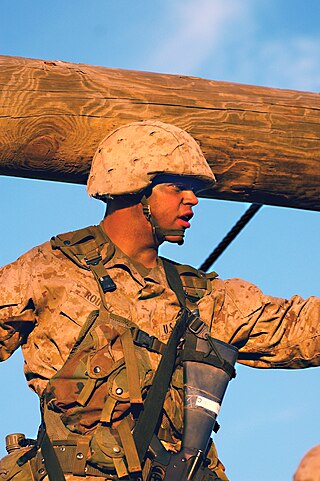
The IIFS was introduced in 1988, to serve as a fighting and existence carrying system—a possible replacement for the All-purpose Lightweight Individual Carrying Equipment employed and fielded by United States Armed Forces since 1973.

Ultralight backpacking is a style of lightweight backpacking that emphasizes carrying the lightest and least amount of gear. While no technical standards exist, some hikers consider "ultralight" to mean an initial base weight of less than 4.5 kg (9.9 lb). Base weight is the weight of a fully loaded backpack at the start of a trip, excluding worn weight and consumables such as food, water, and fuel. Base weight can be lowered by reducing the weight of individual items of gear, or by choosing not to carry that gear. Ultralight backpacking is most popular among thru-hikers.
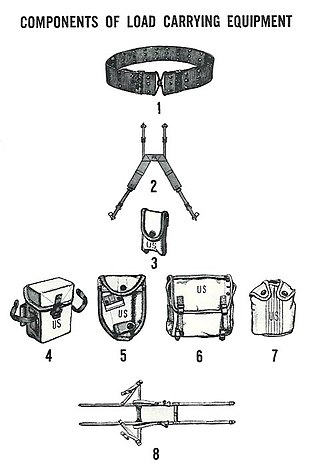
The M-1956 Load-Carrying Equipment (LCE), also known as the Individual Load-Carrying Equipment (ILCE), was developed by the U.S. Army and first issued in the early 1960s. The M-1956 LCE was designed to replace the M-1945 Combat Pack, the M-1923 cartridge belt, the M-1936 pistol belt and the M-1937 BAR magazine belt. The M-1956 LCE was designed to be quickly configured, using no tools, to accommodate various mission and ammunition loads. The M-1956 LCE remained in service through the 1980s and set the standard for future United States military load-carrying equipment.

A haversack, musette bag, or small pack is a bag with a single shoulder strap. Although similar to a backpack, the single shoulder strap differentiates this type from other backpacks. There are exceptions to this general rule.
The Lightweight Rucksack was the primary rucksack utilized by United States troops during the Vietnam War and also used in arctic and alpine areas. It replaced the M1952 rucksack and was in turn replaced by the ALICE in 1973. The 1967 Training Circular TC 10-8. Lightweight Rucksack: Nylon OG106 served as a "how to use" manual.

Fastpacking is a combination of trail running and ultralight backpacking. It is described by writer Clint Cherepa as "hiking the ups, jogging the flats, and running the downs", depending on the gradient, because of the weight carried. Participants carry a light pack with essential supplies, including a sleeping bag and tent, or similar form of shelter, if mountain huts or other accommodation is not available. The weight carried will vary but fastpackers aim at no more than 15 pounds (6.8 kg) and some achieve less than 10 pounds (4.5 kg). This activity may be undertaken either unsupported, self-supported, or supported. "Unsupported fastpackers make no use of outside assistance along the route", while self-supported fastpackers will leave caches of supplies along the intended route.
The Duluth Pack company is a manufacturer and supplier of Duluth pack style packs. They also produce and sell a range of other products, especially other bags and accessories built in the style of their packs. The company grew out of the shoe repair business started by Camille Poirier in 1870. He patented the #3 Duluth pack in 1882 and later sold the canoe pack business to an outdoor supply store in downtown Duluth, Minnesota, where it is still located. The company is led and owned by Tom Sega.

















